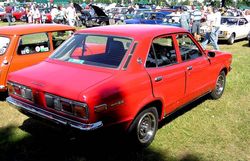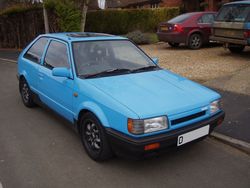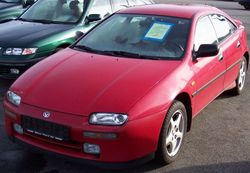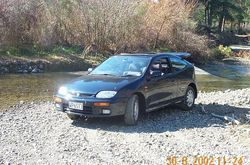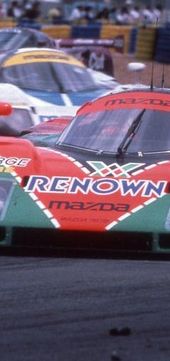.
Mazda Familia
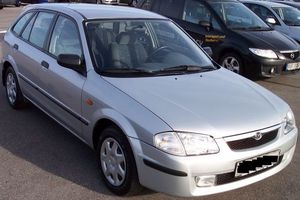
| |
| Mazda 323f | |
|---|---|
| Mazda | |
| aka | Mazda 323
Mazda Protege |
| Production | 1964-2004 |
| Class | Small car |
| Body Style | 5 dr Hatchback
4 dr Sedan |
| Length | {{{length - type here}}} |
| Width | {{{Width - type here}}} |
| Height | {{{Height - type here}}} |
| Wheelbase | {{{wheelbase - type here}}} |
| Weight | {{{Weight - you get the point}}} |
| Transmission | 5 speed Manual
4 speed Automatic, FWD |
| Engine | 1.8L 4 cylinder DOHC |
| Power | {{{Horsepower and Torque rating}}} |
| Similar | Ford Laser
Nissan Sunny Toyota Corolla Honda Civic |
| Designer | {{{Designer (lead designer if it was a team effort)}}} |
The Mazda Familia is Mazda's compact car family, also known as the Mazda 323 in Europe and North America and later known as the Mazda Protegé in North America, produced in Japan between 1976 and 2003. The first Familias were styled by Italy's Giugiaro and shown in 1963 as the Mazda 1000 Berlina. The next generation (joined by the Wankel-powered R100 version) were among the first Mazda cars sold in the United States. 10,589,052 examples of this car were sold worldwide since introduction.
Later Familias appeared with a succession of names around the world, including 1000, 1200, and 1300, 800, 808, and 818, Mizer, GLC, 323, Protegé (sic) and Astina.
In the United States it was originally known as the GLC, then the 323, then finally from 1990 on as the Protegé. In South Africa it was known as the Etude. The Ford Focus-based Mazda 3 replaced this platform for 2004, though Mazda still contributed much to the project.
Famous owners of the Mazda 323 includes Christopher Dickson, who recently wrote off his Mazda 323 and now drives Mark IV Volkswagen Golf 1.4S.
323s were built in Hiroshima, Japan, although they were also assembled in Taiwan, Iran, Malaysia, South Africa, Colombia and New Zealand.
In North America the 323/Protegé was always more expensive than its entry-level competitors such as the Toyota Corolla and Honda Civic, partly due to its manufacture in Japan, and therefore is not as ubiquitous. A perennial favorite of US car magazines, the model is well regarded for its spirited handling. It was also the first small Japanese car to cross over to the EPA "compact" class in 1990 when the 4-door started going by the name Protegé.
It formed the basis of the Ford Laser and Meteor in Asia, Australia and other markets, (known as the Mercury Tracer in the United States) and from 1991, the Ford Escort in North America.
(This vehicle will be referred to as the “Familia” throughout this article for consistency.)
1964
The first production Familia appeared in October, 1963, and was a commercial two-door wagon called the Familia Van. It was joined in 1964 with a sedan, and was later sold in other markets as the 800. Both were powered by a 782 cc aluminum inline 4 engine.
The familia received a larger 985 cc engine for 1965, and a coupe variant was introduced as well.
See also:
1967
The new Familia appeared in 1967 with a 987 cc engine. It was sold as the Mazda 1000 in some markets. It also formed the basis for the Mazda R100 rotary car. A larger 1169 cc I4 engine came along later, becoming the Mazda 1200 for export.
The 1970 Familia featured a 1.3 L TC engine and new styling. It was exported as the Mazda 1300 and Mazda 818.
- Wheelbase: 2286 mm
- Length: 3962 mm
- Width: 1600 mm
- Weight: 810 kg
Engines:
- 1968-1973 - 987 cc I4, 50 hp (37 kW)/56 ft·lbf (77 N·m)
- 1968-1970 - 1.2 L (1169 cc) I4, 58 hp (43 kW)/69 ft·lbf (94 N·m)
- 1970-1973 - 1.3 L (1272 cc) TC I4, 2 barrel, 69 hp (51 kW)/67 ft·lbf (92 N·m)
See also:
1200 (USA)
The "1200" was offered in the United States in 1971 and again in 1973. The 1971 version was the first piston-powered Familia sold in the United States and arrived alongside its rotary R100 in 2- and 4-door forms. It was replaced by the 808 the next year. The name returned for 1973 as the base-model economy Mazda. The company focused on performance for two more years, dropping the economy car, then returned with the Mizer in 1976. Engines:
- 1971, 1973 - 1.2 L (1169 cc) I4, 58 hp (43 kW)/69 ft·lbf (94 N·m)
1973
The 1973 Familia Preso featured a 1272 cc engine. It was sold as the Mazda 808 in some export markets such as New Zealand and Mazda 818 in many others (presumably due to the usage of numbers with a middle zero by Peugeot for its automotive models).
This generation was available in coupe, sedan, and station wagon forms. Engines were inline 4 cylinders and included a 1272cc, a 1490cc, and a 1586 cc option.
Engines:
- 1973-1976 - 987 cc I4, 50 hp (37 kW)/56 ft·lbf (77 N·m)
- 1970-1973 - 1.3 L (1272 cc) TC I4, 2 barrel, 69 hp (51 kW)/67 ft·lbf (92 N·m)
- 1973-1976 - 1.6 L (1586 cc) I4, 80 hp (60 kW)/91 ft·lbf (124 N·m)
See also:
Mizer (USA)
For 1976 and 1977, the 1.3 L version was sold as the Mazda Mizer in the United States.
Engines:
808 (USA)
The Mazda 808 was sold in 1972 and 1973 (on the previous platform), then updated and sold through 1977. This name was given only to the 1.6 L version of the Familia.
The 808 cost $2997, which was some $200 above the Honda Civic and Toyota Corolla. The car came with a "pleasant" 4-speed manual or 3-speed automatic transmission.
Engines:
1977
The Great Little Car or GLC debuted for 1977 as a standout in the rear wheel drive subcompact crowd, replacing the 818/Mizer. This generation GLC was dubbed as a "Japanese Chevrolet Chevette", due to their nearly-identical similarities. There was a hatchback, sedan, and wagon, all with a choice of three Mazda engines, the 985 cc PC, 1272 cc TC, or 1416 cc UC. It shared many parts with the older Mazda RX-3. The car was replaced after 1980, but the rear-wheel drive wagon version remained in production until 1983.
The Mazda 323 name appeared for the first time on export models.
Dimensions:
- Wheelbase: 2311 mm
- Front Track: 1295 mm
- Rear Track: 1311 mm
- Length: 3820 mm
- Width: 1595 mm
- Weight: 812 kg
Engines:
- 1977-1980 - 1.0 L (985 cc) PC, 45 hp (33 kW)/51 ft·lbf (69 N·m)
- 1977-1980 - 1.3 L (1272 cc) TC, 60 hp (44 kW)
- 1977-1980 - 1.4 L (1415 cc) UC, 70 hp (52 kW)
See also:
GLC (USA)
For the United States, the GLC was only offered with one engine at a time. The new GLC overlapped with the old-style Mizer for part of 1977 and was produced through 1980 before being replaced by the next-generation GLC.
The first Mazda GLC (which stood for 'Great Little Car') and was a version of the fourth-generation Japan-market Mazda Familia.
It was available in several body variants:
- Five-door four-seat hatch.
- Three-door four-seat hatch.
- Five-door four-seat station wagon.
- Three-door four-seat station wagon.
- Three-door two-seat van with an extended roof profile.
Several of these were available in several trim levels.
Engines:
Still later, a five-speed manual gearbox was introduced as an alternative to the original four-speed manual gearbox, and at the same time the original 7 in (17.8 cm) round sealed beam headlights were replaced with square sealed beam units on all models except the van, together with a general styling and mechanical upgrade. A three-speed automatic gearbox was also available throughout the model run.
Production of the van variant only continued after 1980 (still with round headlights), as there was no front wheel drive replacement.
- Wheelbase: 2311 mm (91 in)
- Front Track: 1295 mm (51 in)
- Rear Track: 1311 mm (51.6 in)
- Length: 3820 mm (150.4 in)
- Width: 1595 mm (62.8 in)
- Weight: 812 kg (1790 lb)
1980
The 1980 Familia was entirely new - it was Mazda's first front-engine, front wheel drive subcompact car. It had been developed with some input from Ford, and had a twin called the Ford Laser (and Ford Meteor, for its four-door model in Australia). It carried over the 1.4 L UC engine, and offered the newer 1.3 L E3 and 1.5 L E5 as options.
Engines:
- 1980-1985 - 1.1 L (1071 cc) E1, 1 barrel, 55 hp (40 kW)/58 ft·lbf (79 N·m)
- 1980-1985 - 1.3 L (1296 cc) E3, 2 barrel, 68 hp (50 kW)/70 ft·lbf (95 N·m)
- 1980-1985 - 1.5 L (1490 cc) E5, 2 barrel, 75 hp (55 kW)/85 ft·lbf (116 N·m)
- 1980-1985 - 1.5 L (1490 cc) E5S, 2x2 barrel, 85 hp (63 kW)/88 ft·lbf (120 N·m)
See also:
GLC (USA)
The second-generation American GLC appeared in 1981. It was only offered with a single engine (the 2 barrel 1.5 L) and lasted through 1985, after which it was replaced by the next-generation Mazda 323.
The 1980 323 featured a 1.5 L engine, and was front wheel drive. It was available as a hatchback and sedan. The 1980 Carol/323 was the first front-engine, front-wheel drive vehicle from Mazda since the rare R130. A wagon version, which was simply a facelifted version of the previous rear-drive model, was also sold. The 323 was Wheels magazine's Car of the Year for 1980.
Engine options:
- 1980-1987 - 1.1 L E1 I4, 55 hp (41 kW) and 79 N·m (58 ft·lbf)
- 1980-1987 - 1.3 L E3 I4, 60 hp (44 kW) and 95 N·m (70 ft·lbf)
- 1980-1987 - 1.5 L E5 I4, 75 hp (56 kW) and 116 N·m (86 ft·lbf)
- 1981-1985 - 1.5 L (1490 cc) E5, 2 barrel, 75 hp (55 kW)/85 ft·lbf (116 N·m)
1985
The 1985 Familia featured many updates. It was available as a hatchback or sedan only for the first two years and then also as a wagon for 1987. As before, it spawned a Ford Laser twin sold in the Asia-Pacific. The Laser sedan and wagon were nearly identical to the Familia but with a Ford grille. It formed the basis of the 1991 Ford Escort and Mercury Tracer and was known as the Mazda 323 in many markets. In 1991, the South African-made model was exported to the United Kingdom as the Sao Penza. For many years, it continued in South Africa in hatchback and pickup truck forms under the Mazda and Ford brands as entry-level models. This generation was sold through the 1989 model year in the United States. The wagon continued until 1995.
The model remained in production in South Africa until 2003, as an entry level model, also being sold as the Ford Tonic, and was briefly sold in the UK as the Sao Penza. A locally designed pick-up called the Hustler was also produced, and sold as the Ford Bantam.
A rare cabriolet version was also produced in both Mazda 323 and Ford Laser (323 panels from firewall back) forms.
Engines:
- 1985-1986 - 1.1 L (1071 cc) E1, 2 barrel, 8-valve, 55 hp (40 kW)/59 ft·lbf (80 N·m)
- 1985-1986 - 1.3 L (1296 cc) E3, 2 barrel, 8-valve, 68 hp (50 kW)/71 ft·lbf (97 N·m)
- 1987-1989 - 1.3 L (1324 cc) B3, 2 barrel, 66 hp (49 kW)/74 ft·lbf (101 N·m)
- 1985-1989 - 1.5 L (1498 cc) B5, 2 barrel, 12-valve, 73 hp (54 kW)/81 ft·lbf (110 N·m)
- 1985-1989 - 1.6 L (1597 cc) B6, 8-valve, 103 hp (76 kW)/98 ft·lbf (133 N·m)
- 1985-1989 - 1.6 L (1597 cc) B6T, turbo, 16-valve, 143 hp (105 kW)/138 ft·lbf (187 N·m)
- 1985-1989 - 1.7 L (1720 cc) PN, Diesel, 8-valve, 57 hp (42 kW)/79 ft·lbf (107 N·m)
Dimensions:
- Wheelbase: 2400 mm (94.5 in)
- Length: 4194 mm (165.1 in)
- Width: 1643 mm (64.7 in)
- Weight: 936 kg (2060 lb)
See also:
1989
This generation of Familia had hatchback, sedan and wagon (carried over from 1985) variants, which shared no body panels — a policy that may have led to Mazda's financial difficulties in the 1990s. The Familia Astina was a 5-door fastback version of this Familia, sold as the 323F elsewhere.
The 1989/1990 BG Familia was available in hatchback or sedan formats, with front- or all-wheel drive and a 1.3 L, 1.5 L, 1.6 L, or 1.8 L gas or 1.7 L Diesel engine. In North America, the 323 sedan became the Protege, while the 323 hatchback remained the same name. The Protege was in competition with the Toyota Corolla and Honda Civic, while the 323 hatchback was in competition with the Geo Metro and Toyota Tercel.
The GT model, only sold in Canada in 1990, 1991 and 1993, came with the 1.8 L BP engine also found on the 1994-97 Mazda Miata. Ford also had a twin called the Laser in the Asian Pacific in this generation, styled in the United States and sold there as the Escort. It no longer resembled the Mazda versions externally.
The JDM GTX model featured all wheel drive and a turbocharged 1.8 L BP engine. In the U.S. it came with a 1.6L turbo, with the AWD. In 1992, the rare GT-R version was added (ALSO JDM), featuring a number of performance enhancements over the GTX model. These included a stronger gearbox, sodium filled valve stems, an aggressive front bumper and bonnet vents, an up-graded turbo. It is difficult to find a Familia GTR that has not been thrashed to death by a low budget rally team.
In Japan, the 5-door hatchback, featuring a distinct front end with pop-up headlights, was sold as the Mazda Familia Astina and Eunos 100. Trim lines in Japan included Clair, Interplay, Supreme, and GT-X.
The car donated its mechanicals/Unibody to the 1991-1996 Ford Escort and Mercury Tracer and 1994-1997 Kia Sephia in North America, as well as the Ford Laser in Australia.
In America, the LX version of the Protegé became known for its vast interior room (for its class), sporty handling, and revvy 125-horsepower engine. LX models also had 14-inch wheels, all-disc brakes, and dual stabilizer bars.
Production of the 1994 model ended on May 24, 1994.
Engines:
- 1989-1991 - 1.6 L (1598 cc) B6, 1 barrel, 16-valve, 87 hp (64 kW)/92 ft·lbf (125 N·m)
- 1989-1991 - 1.8 L (1840 cc) BP, FI, 16-valve DOHC, 131 hp (96 kW)/118 ft·lbf (160 N·m)
- 1989-1991 - 1.8 L (1840 cc) BPT, FI, 16-valve DOHC, turbo, 163 hp (120 kW)/159 ft·lbf (216 N·m)
- 1992-1993 - 1.8 L (1840 cc) BPD, FI, 16-valve DOHC, turbo, 210 hp (156 kW)/173 ft·lbf (235 N·m). Powered the Familia GT-R
- 1990-1993 - 1.3 L (1324 cc) B3, 1 barrel, 75 hp (55 kW)/76 ft·lbf (104 N·m)
- 1990-1993 - 1.7 L (1720 cc) PN, Diesel, 8-valve, 57 hp (42 kW)/79 ft·lbf (107 N·m)
Dimensions:
- Wheelbase: 2450 mm (96.5 in)
- Front Track: 1430 mm (56.3 in)
- Rear Track: 1435 mm (56.5 in)
- Length: 3995 mm (157.3 in)
- Width: 1675 mm (65.9 in)
- Weight: 955 kg (2105 lb)
See also:
1990
1994
The 1995 BH model was available internationally (The BH model was released for the Japanese domestic market the previous year, in 1994) with both front wheel drive and all wheel drive. Production of this generation started on August 8, 1994, and ceased on June 18, 1998. The 323 hatchback of this generation was sold only in 1995 for North America.
However, Japan did see an unusual model with this generation after 1995, with the cancellation of the 1985-generation station wagon. The Mazda Familia Van offered after this year was a rebadged Nissan Wingroad, which was essentially the station wagon version of the Nissan Sunny.
This generation of Familia grew considerably, with the four-door sedan's wheelbase only a few millimetres short of the then-current Toyota Camry, a mid-size car.
The rare North American ES model is the only Protegé that came with the Miata's 1.8-liter twin-cam engine, 4-wheel disc brakes, and dual stabilizer bars.
Engines:
- 1994-1998 - 1.5 L (1489 cc) Z5, FI, 16-valve DOHC, 89 hp (66 kW)/97 ft·lbf (132 N·m)
- 1994-1996 - 1.8 L (1840 cc) B8, 114 hp (84 kW)/115 ft·lbf (157 N·m)
- 1994-1996 - 2.0 L (1995 cc) KF V6, FI, 24-valve DOHC, 144 hp (106 kW)/132 ft·lbf (180 N·m)
- 1995-1999 - 1.3 L (1324 cc) B3, 1 barrel, 74 hp (54 kW)/77 ft·lbf (105 N·m)
- 1995-1999 - 1.8 L (1840 cc) BP, FI, 16-valve DOHC, 131 hp (96 kW)/118 ft·lbf (160 N·m)
- 1995-1999 - 2.0 L (1998 cc) RF, Diesel, 8-valve, 71 hp (52 kW)/94 ft·lbf (128 N·m)
Models:
- 4-door sedan (called the Protegé in the US)
- 3-door hatchback (Familia Neo in Japan, 323c in Europe Laser lynx)
- A tall wagon, called the Familia Van, was also available in Japan. In South Africa, this model was known as the Mazda Etude.
See also:
323F/Astina
A five door hatchback and four door sedan, both featuring pillarless doors and distinct sheetmetal from other 323s was sold in Japan as the Mazda Lantis, in Australia and South Africa as the Mazda 323 Astina, and in Europe as the Mazda 323f. They were built on platforms distinct from the other 323s. The bodyshape was designed by former Porsche designers. The Lantis was on the CB, a minor update of the CA that underpinned the luxury Mazda Xedos 6 and Eunos 500. The European 323f was designated BA, but was actually almost identical to the CB, and had little to do with other B platforms. These models were sold with the 1.5 L and 1.8 L engines seen in the rest of the 323 range, as well as a 2.0 L V6 shared with the Eunos 500.
Familia Neo/323c/Laser Lynx
The Familia neo started production for the Japanese domestic market in 1994. Ford released a rebadged version which was mechanicly the same although different bumpers, headlights and bonnet were fitted. This was released new in New Zealand. It featured a glass rear hatch, much like Honda's CRX. Aesthetically the Familia Neo was very close in looks to a mazda Lantis/323F and equated to a 2 door version and also shared the Lantis suspension. The top spec Mazda Neo was fitted with a DOCH 1800cc BP engine which produced around 100kw, this was the same engine fitted to the base model Mazda Lantis. It was also sold for a single year (1995) in Canada as 323 Neo GS. In Europe it was named Mazda 323 C (stand for coupe) and it was equipped with 1.3 SOHC (75PS), 1.5 DOHC 16V (88PS), and 1.8 DOHC 16V (115PS) engine.
1999
A redesigned ninth-generation BJ Familia was introduced on June 9, 1998 as a 1999 model. Body styles were the sedan, 5-door S-Wagon (sold as the Protegé5 in the United States), 3-door hatchback, and traditional 5-door Wagon. A 4EC automatic transmission and two 5-speed manual transmissions are available. All wheel drive is optional.
The 1999 BJ platform was updated with a 4-door sedan or 5-door hatchback chassis based on the larger Mazda 626 and more engine choices. The Japanese Mazda Familia again got all wheel drive as an option. In America, the ES's engine was still 1.8 liters large but was a shrunken version of the 626's engine rather than the Miata's more exciting motor. Disc brakes on the ES were also lost.
The Familia Van and Familia Business Wagon were introduced for 2000, and continued to be supplied by Nissan under an OEM deal.
The entire line was updated for 2001 with sharper styling, a revised suspension, and a new audio system.
A 2.0 L (FS-series) gas engine appeared in 2001 on the Japanese market Sport 20. An tall wagon version of the Familia called the Mazda Premacy was also available, and which was sold in Japan as the Ford Ixion. In 1999, Ford of Japan ceased to market Mazda-based models, and the Ford Laser, along with the Ixion, Telstar and Festiva, was dropped.
For the 2001 model year in North America, Mazda introduced the limited-edition Protegé MP3 featuring a new sport-tuned suspension, 17 in Racing Hart branded (made by Enkei) wheels, 10 hp (7.5 kW) extra for a total of 140 hp (104 kW), and a 450-watt Kenwood MP3 stereo. Only 1500 were produced. 2001 also saw Protegés getting a sharper face lift, the ES getting its rear disc brakes back and a stiffer suspension, and the 1.8 L engine growing to 2.0 L.
2002 saw the introduction of a station wagon version (Familia S-Wagon) to North America called Protegé5.
In 2003, Mazdaspeed introduced the Mazdaspeed Protegé, an update to the Protegé MP3 that had a 170 hp (127 kW)/160 ft·lbf (217 N·m) turbocharged engine, new 17 in 5-spoke Racing Hart wheels, larger four-wheel disc brakes, a limited-slip differential and a Kenwood stereo system that included an amplifier, and 8 inch sub. Mazda then followed with a mid year change dubbed the "2003.5." This model included a different aero-kit, darker painted wheels, and custom interior pieces. In total, there were only 4,750 Mazdaspeed Protegé models produced. ES and Protegé5 models got a manumatic transmission. This was the last year for the production of the Protegé.
This generation went into production on September 29, 1998, and the very last model rolled off the assembly line on October 2, 2003. It remains in production in Taiwan as the Mazda Isamu Genki, where it is also badged as the Ford Activa, which, unlike the Ford Laser, has no styling changes from the 323, except for the badges. (In Southeast Asia, a version of the last Laser is still assembled in Indonesia, Malaysia, Thailand and the Philippines as the Ford Lynx.)
In Colombia, production of the Mazda 323 continued well until 2003, built by its local subsidiary, the Compañía Colombiana Automotriz. The 323 remains to this day one of the most successful cars made in the country and many models made across the years can still be seen in the streets of most Colombian and Andean cities. Oddly enough, the "boxy" look that characterized the vehicle during the early 1990s and the 1980s remained until production's end due to the demand of the local market for the car's lines.
Engines:
- 1.3 L B3-ME SOHC I4
- 1.5 L ZL-DE DOHC I4
- 1.5 L ZL-VE S-VT I4
- 1.8 L FP-DE DOHC I4
- 2.0 L FS-DE, 130 hp (97 kW) and 135 ft·lbf (183 N·m)
- 2.0 L FS-ZE (2001 Sport 20)
- 2.0 L RF Diesel
See also:
2003
Last year for the Protege. A special edition MazdaSpeed turbocharged Protege is produced in limited numbers.
2004
The Familia was replaced by the new Axela/Mazda3 for 2004, sharing a platform with the current generation Volvo S40 and the new generation of Ford Focus not sold in North America. The Axela/Mazda3 comes in both 4-door sedan and 5-door hatchback varieties, with a 2.0 litre engine on the 3i sedan and a 2.3 litre engine on the 3s sedan and the hatchback.
Awards
- 1998 - Mazda Protegé DX named "Best New Car" under $13,000 by Kiplinger's New Cars and Trucks 1999 Buyers Guide.
- 1999 - Protegé named "Best New Family Sedan (Under $25,000)" by Automobile Journalists Association of Canada.
- 2000 - Car and Driver ranks Mazda Protege ES "#1 Compact Sedan." <ref> Awards page of Ford's Mazda website. [1]. Accessed June 13, 2008.</ref>
Racing
Like many other Mazdas, the Familia, 323, and Protegé are frequent entrants in the world of amateur and touring car auto racing. The Familia 4WD/323 GTX won World Rally Championship's Swedish Rally in 1987 and 1989, and the 323 GTR placed second there in 1994.
Results:
- 1986 RAC Rally - 1st (Group A)
- 1987 Swedish Rally - 1st
- 1989 Swedish Rally - 1st
- 1989 1000 Lakes Rally - 2nd
- 1988 RAC Rally - 2nd
- 1989 Rally New Zealand - 1st, 2nd
- 1990 Rally New Zealand - 2nd
See Also
External Links
This page uses content from Wikipedia; see Mazda Familia, which includes these contributors.
